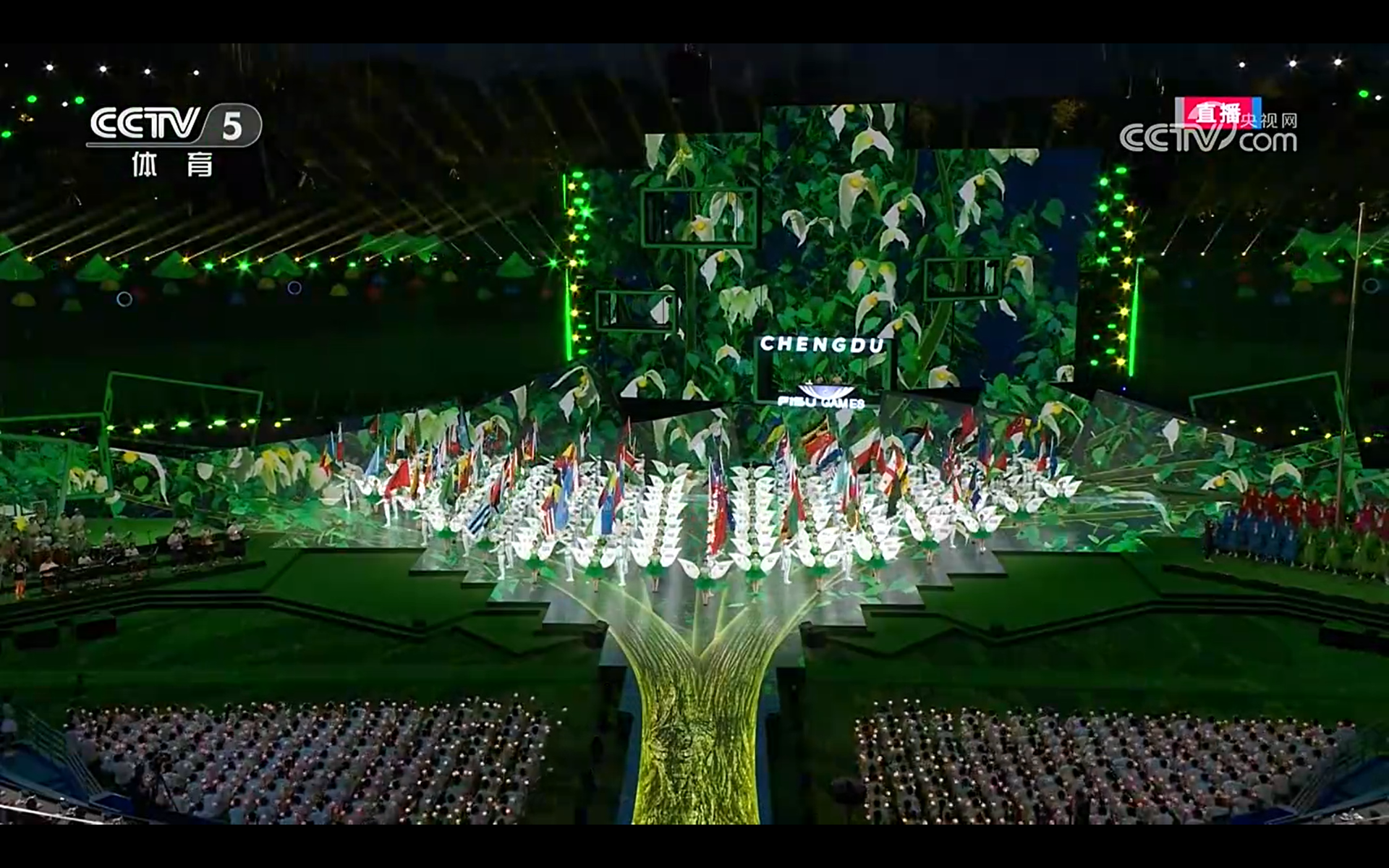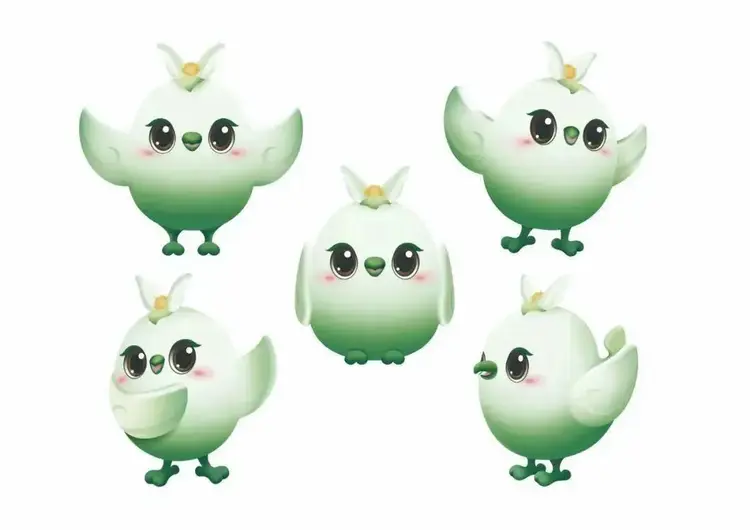"Xiao looks at the red wet place, and the flowers are heavy in the official city", what are the new green and low-carbon highlights of the Chengdu World Garden?
Do you still remember the impressive naked-eye 3D dove tree at the closing ceremony of the Chengdu Universiade last year? This year, it has become the focus of attention again in Chengdu. This time, it has been transformed into the mascot of the 2024 Chengdu World Horticultural Exposition (hereinafter referred to as the "Chengdu World Horticultural Expo").

The Chengdu World Horticultural Expo will be held from April 26 to October 28, lasting for 186 days, with the theme of "Park City, Beautiful Habitat". It is worth mentioning that the concept of "green and low-carbon, economical and sustainable, shared and inclusive" has become a new highlight of this year's EXPO. How is the low-carbon concept of the expo embodied, and what is the significance of holding it in a park city? To this end, this reporter interviewed relevant experts and staff.
Preparing a low-carbon plan for the first time, low-carbon design "hidden mysteries"
The concept of green and low-carbon runs through the whole cycle of the exhibition, which is a major attraction of the 2024 Chengdu World Horticultural Expo.
It is understood that in the preparation and construction, the Chengdu World Horticultural Exhibition has prepared and issued a "low-carbon management plan", which is the first time since the establishment of the World Horticultural Exhibition more than 60 years ago. This year's EXPO adopts the concept of low-impact development to create a green and low-carbon ecological park.
"It is hoped that through a total of 23 measures in seven aspects, including ecological construction, venue construction, energy supply, transportation, publicity activities, service management, and park operation, a total of 23 measures will be 'combined online' to achieve the low-carbon 'green blueprint' and low-carbon goals of the Chengdu World Horticultural Expo, and make this World Horticultural Expo a platform and window for China to show its green ecological civilization to the world." The relevant person in charge of Chengdu Horticultural Expo Operation and Development Co., Ltd. said.
From the main exhibition hall to other venues, and even the main entrance of the World Horticultural Expo, there are "hidden mysteries".
At the entrance of the main venue, visitors are greeted by three large "hibiscus petals" with beautiful shapes, and behind the unique shapes, they also have the function of collecting rainwater and recycling it.
The relevant person in charge of Chengdu Horticultural Expo Operation and Development Co., Ltd. said: "The three 'petals' standing in the center of the main entrance are hidden 'rainwater collection artifacts', and the rainwater is gathered to the center through the petals and introduced into the underground rainwater filtration and storage system by a pipe with a diameter of 250 mm. It is estimated that about 2,500 tons of rainwater will be collected annually, which can meet the daily irrigation water of the park's 2 hectares of green space. ”
In the design and construction of the main exhibition hall, the builder inherited the traditional wisdom and made full use of natural ventilation and lighting, so that the building can take into account the summer shading and winter heat collection, reduce the energy consumption of operation and maintenance, and at the same time cleverly introduce the low temperature fresh air on the lake surface to reduce the energy consumption of air conditioning.
"The main exhibition hall cleverly 'breaks down the air conditioner into zero' and uses more decentralized air conditioning, which saves energy equivalent to the annual energy consumption of 30 ordinary households. The relevant person in charge of Chengdu Horticultural Expo Operation and Development Co., Ltd. said.
Other venues are adopting new green building technologies such as small air-conditioning systems, photovoltaic glass, and composite insulation walls to achieve the overall goal of reducing carbon emissions.
In addition, there are many green and low-carbon measures adopted by the Chengdu World Horticultural Expo. For example, a complete sponge system has been established, energy-saving equipment has been adopted, and photovoltaic panels have been installed.
Native tree species are retained and the original topography is utilized
On the side of the passage leading to the main exhibition hall, there is a well-grown forest with a sign that reads "Reserved Forest", which turns out to be the "aborigines" of the area. Giving priority to the use of native plants is also one of the low-carbon measures proposed by this year's EXPO.
To this end, the Chengdu World Horticultural Association specially compiled the "Special Research on Plants", which takes the protection of native tree species as an important task to ensure that every tree in the map is "on the job".
"The main venue will maintain the original topography and landform, and give full play to the aquatic ecological functions of the original rivers and lakes. According to the current situation of the park, the forest and native tree species such as maple poplar, camphor and cypress are fully retained. At the same time, the existing nurseries within the park are retained and transplanted on the spot. Zhou Liyun, chief planner of Chengdu Park City Construction and Development Research Institute, introduced.
In fact, the original forest can be preserved, and the original terrain can be used as much as possible, which can reduce earthwork excavation and reduceCarbon emissions。 In addition, the use of raw stone in situ will also reduce the environmental load.
It is understood that the total land use of the six main buildings accounts for less than 10%, the blue and green space accounts for 90%, the terrain and landform are retained 60%, the earthwork in the field is self-balanced, the water area is expanded to 560 acres after dredging and dredging, and nearly 3 kilometers of ecological river channels are formed, and 113 exhibition gardens are competing to bloom, interpreting the vivid picture of harmonious coexistence between man and nature.
In particular, the interior space of the building is designed to provide the most suitable growth conditions for rare plants, and through energy-saving and low-consumption technical means, to create a green, low-carbon, scientific and ecological, plant seed home.
Good ecological background, showing the achievements of park city construction
The most beautiful April day in the world, the dove tree enters the full flowering period. In Chengdu, the dove tree is mainly distributed in the Longmen Mountains, and the Chengdu World Horticultural Exhibition branch venue Qionglai is the concentrated growth area of the dove tree.
The mascot of the Chengdu World Horticultural Exhibition "Tong Meier" is based on the "Bronze Divine Bird" and the dove tree, and has gained a large number of fans with its super cute and well-behaved image.

It is known as the "living fossil" of the plant kingdom and is a unique relict plant in China. This plant, which came from 60 million years ago, is a national first-class protected plant, known as the "giant panda of the plant world", and is also known as the "living fossil" of the plant world.
"The environmental requirements of the habitat are extremely harsh, and basically the field survey only grows in the place where the forest is well preserved and has not been subjected to human destruction and pollution, so the existence of wild dove tree can also reflect the good ecological environment of a certain area. Pan Zhe, a senior engineer at the Ecological Civilization Research Center of the Sichuan Provincial Academy of Environmental Policy Research and Planning, said.
The reason why Chengdu was chosen to host the EXPO is inseparable from the good biodiversity background of Chengdu and Sichuan Province.
Sichuan Province has always attached great importance to the conservation of biodiversity, and remarkable progress has been made in the conservation of wild plants. "Sichuan Province has successively established 530 nature reserves of various levels and types, systematically and completely protecting the typical natural ecosystems and natural distribution areas of rare and endangered plants in the province. A number of research institutions have continued to carry out background research on biodiversity, and in recent years, new plant species such as Meigu hedgewood, Wolongjuan petal orchid, and panda Artemisia have been discovered. Pan Zhe said.
As a megacity in the western region, Chengdu has a good ecological background, with more than 12,000 species of higher plants and more than 6,500 species of endemic plants in China, is the country's main water conservation area and biodiversity enrichment area, and has an important position in the national ecological security pattern and the ecological protection of the Yangtze River, with the country's first ecological civilization construction theme park, 15 districts (cities) and counties have been rated as national ecological civilization construction demonstration zones, and a total of more than 7,000 kilometers of Tianfu Greenway have been built, and it has successfully won the first global "Biodiversity Charm City" Awards.
In February 2018, General Secretary Xi Jinping first proposed the concept of "Park City" when he visited Chengdu.
"Hosting this expo is also an important platform to show the world the achievements of Chengdu's park city construction, which is conducive to conveying the concept of green development and promoting the construction of ecological civilization. Zhou Liyun said that this year's EXPO will fully run through the main tone of green development, relying on natural mountain water resources, rich terrain and landforms, following the natural texture, homeopathic soil and water, and planting trees and greenery according to the place, fully embodying the characteristics of Chengdu Park City, and showing the new practice of park city and the new picture of beautiful China to the world.
It is understood that the total number of Chengdu World Horticultural Exhibition Parks, the number of overseas exhibition parks, and the number of associations and enterprise exhibition parks have all set a record for the previous Class B World Horticultural Expo. In addition to flower and horticultural exhibitions, more than 2,000 events will be held, with an average of 10 per day, and it is expected to attract 5 million visitors.
The use of the park after the previous World Horticultural Expos has always been the focus of social attention. In accordance with the principle of "demand-oriented, sustainable utilization", this year's EXPO will coordinate the transformation and utilization of the functions of the venue during and after the exhibition, and transform it into an urban function project after the exhibition. The core building will be transformed into a garden museum, a cultural and art center and other facilities to better meet the needs of people's cultural life.







